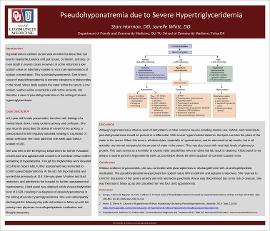| dc.description.abstract | INTRODUCTION: Hyponatremia is defined as low sodium within the blood that can lead to headache, balance and gait issues, confusion, seizures, or even death in severe cases. However, in some instances a low sodium value on laboratory studies is not a true representation of sodium concentration. This is pseudohyponatremia. One known cause of pseudohyponatremia is extreme elevations in triglycerides in the blood. When lipids replace the water within the serum, a low sodium number will be recorded but will not be accurate. We describe a case of pseudohyponatremia in the setting of severe hypertriglyceridemia.
CASE DESCRIPTION: extreme anxiety and confusion. She was recently prescribed 30 tablets of Ativan for her anxiety, a prescription that she regularly obtained, leading to a question of Ativan overdose. Her clinic labs from one week ago noted a sodium of 126. She was sent to the Emergency Department for further evaluation of confusion and agitation with concerns of overdose versus further worsening of hyponatremia. Though her triglycerides were elevated at 1,409 on recent labs, further assessment was warranted to confirm pseudohyponatremia. At the ED, her hyponatremia was worse than previously at 119. She was given IV saline and fluid restriction, and admitted to the hospital for further management of hyponatremia. A lipid panel was obtained which showed triglyceride level of 8,520, resulting in a diagnosis of pseudohyponatremia in the setting of severe hypertriglyceridemia. She was subsequently discharged the following day with instructions to follow up with her primary care physician for antihyperlipidemic medication and lifestyle measures.
DISCUSSION: Without evidence of pancreatitis, she was not treated with plasmapheresis or discharged home with an antihyperlipidemic medication. The pseudohyponatremia-associated low sodium value left her delirium and agitation unresolved. She returned to clinic for discussion of her severe anxiety and was referred to psychiatry. Ativan was discontinued due to her risk of overuse. She was then lost to follow up as she cancelled her next four clinic appointments. Although hyponatremia is often a result of dehydration or other common causes including diuretic use, SIADH, and renal failure, pseudohyponatremia should be present in a differential. This case serves as a reminder to explore other possibilities when an abnormal lab result is obtained. A lipid panel is not always a routine part of a hyponatremia work up, but maybe should be when suspicion of common causes is low. | en_US |

